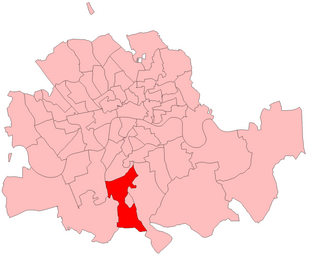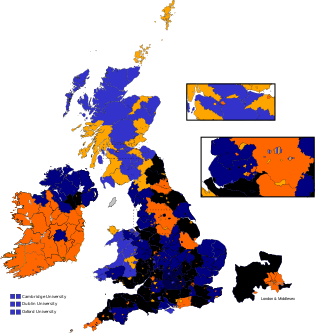
Colne Valley is a constituency represented in the House of Commons of the UK Parliament since 2024 by Paul Davies of the Labour Party.
Peebles and Selkirk was a county constituency of the House of Commons of the Parliament of the United Kingdom (Westminster) from 1868 to 1918. It elected one Member of Parliament (MP) by the first past the post voting system.
Haddingtonshire was a Scottish county constituency represented in the House of Commons of Great Britain and the House of Commons of the United Kingdom from 1708 to 1918.
Falkirk Burghs was a district of burghs constituency of the House of Commons of the Parliament of the United Kingdom from 1832 to 1918. The constituency comprised the burghs of Falkirk, Airdrie, Hamilton, Lanark and Linlithgow, lying in Stirlingshire, Lanarkshire and Linlithgowshire.
Kincardineshire was a constituency of the House of Commons of the Parliament of Great Britain from 1708 to 1801 and of the Parliament of the United Kingdom from 1801 to 1918. It was represented by one Member of Parliament (MP).

Ilkeston is a former United Kingdom Parliamentary constituency. It was a constituency of the House of Commons of the Parliament of the United Kingdom. It was represented by one Member of Parliament. In 1983 it was abolished, together with South East Derbyshire, when the Derbyshire county constituencies were redrawn - the constituencies of Amber Valley and Erewash were created and the constituency of South Derbyshire was re-created.

Gravesend was a county constituency centred on the town of Gravesend, Kent which returned one Member of Parliament (MP) to the House of Commons of the Parliament of the United Kingdom from 1868 until it was abolished for the 1983 general election. It is most notable for being a bellwether, with the winner of Gravesend winning every election from 1918 through to the present day except for 1929, 1951, and 2005.

Clapham was a borough constituency in South London which returned one Member of Parliament (MP) to the House of Commons of the UK Parliament. It was created in time for the 1885 general election then altered in periodic national boundary reviews, principally in 1918, and abolished before the February 1974 general election. In its early years the seat was officially named Battersea and Clapham Parliamentary Borough: No. 2—The Clapham Division.

Salford North was a parliamentary constituency in the City of Salford in Greater Manchester from 1885 until 1950. It returned one Member of Parliament (MP) to the House of Commons of the Parliament of the United Kingdom.

Norwood was a parliamentary constituency in south London which returned one Member of Parliament (MP) to the House of Commons of the Parliament of the United Kingdom by the first past the post system.

Barnstaple was a constituency centred on the town of Barnstaple in Devon, in the South West of England. It returned two Members of Parliament to the House of Commons of the Parliament of the United Kingdom until 1885, thereafter, one.
Islington South was a parliamentary constituency in the Metropolitan Borough of Islington in North London. It returned one Member of Parliament (MP) to the House of Commons of the Parliament of the United Kingdom.
Islington West was a borough constituency in the Metropolitan Borough of Islington, in North London.
Wolverhampton East was a parliamentary constituency in the town of Wolverhampton in Staffordshire, England. It returned one Member of Parliament (MP) to the House of Commons of the Parliament of the United Kingdom.
Thornbury was a county constituency centred on the town of Thornbury in Gloucestershire. It returned one Member of Parliament (MP) to the House of Commons of the Parliament of the United Kingdom, elected by the first past the post voting system.
North Northamptonshire was a county constituency in Northamptonshire, represented in the House of Commons of the Parliament of the United Kingdom. This constituency included the majority of the Soke of Peterborough, with the exception of the actual city of Peterborough itself, which was a borough constituency that returned its own MP.

Whitby was a parliamentary constituency centred on the town of Whitby in North Yorkshire. It returned one Member of Parliament (MP) to the House of Commons of the Parliament of the United Kingdom, elected by the first past the post system.

Radnorshire was created in 1542 as a constituency of the House of Commons of the Parliament of England then of the Parliament of Great Britain from 1707 to 1800 and of the Parliament of the United Kingdom from 1801 to 1918. It elected one knight of the shire (MP) by the first past the post system.

Newington West was a parliamentary constituency in the Newington area of South London. It returned one Member of Parliament (MP) to the House of Commons of the Parliament of the United Kingdom, elected by the first past the post system.
Mid Durham was a county constituency represented in the House of Commons of the Parliament of the United Kingdom. It elected one Member of Parliament (MP) by the first past the post system of election from 1885 to 1918.











